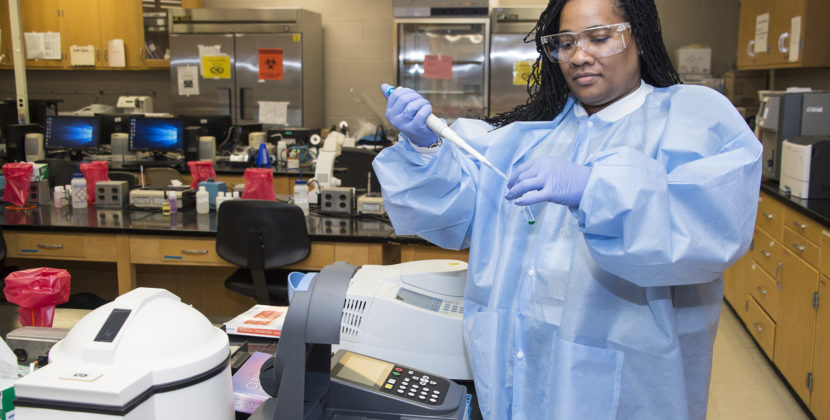The Clinical Laboratory Perspective on COVID-19
Program
9:00 am — Login
9:20 am — Welcome and Introductory Remarks
9:30 am — “Responding to COVID-19: Critical Role of Clinical Lab Practitioners”: Silvia G. Spitzer, PhD, HCLD (ABB)
10:15 am — “COVID Lab Safety Protocols”: Teneka Jean-Louis, PhD / Mindy Leelawong, PhD
11:00 am — “Immunity: Antibody Tests, Antibody Detection”: Rebecca M. Marrero Rolon, MD, D(ABMM)
11:45 am — BREAK
12:15 pm — “Polymerase Chain Reaction (PCR) Testing: COVID-19”: Erika Orner, PhD
1:00 pm — “Isolating and Identifying COVID-19 Strains”: Daniel Seth Fierer, MD
2:00 pm — Participants Receive Program Evaluation Information
Accreditation
Clinical Laboratory Practitioners: This continuing medical laboratory education activity is recognized by the American Society for Clinical Pathology (ASCP) for four (4) CMLE credits. ASCP CMLE credits are acceptable for the ASCP Board of Registry Certification Maintenance Program.
Other Healthcare Professionals: All other healthcare professionals in attendance will receive a general certificate of attendance. Please check with your accreditation board with respect to receiving credit for this program.
9:30 am — “Responding to COVID-19: Critical Role of Clinical Lab Practitioners”:
Presenter(s): Silvia G. Spitzer, PhD, HCLD (ABB)
Since the World Health Organization declaration of the COVID-19 pandemic in March 2020, laboratories around the country have played a crucial role in the detection of the SARS-CoV-2 virus and the management and treatment of infected patients. Many specialties, including chemistry, microbiology, molecular diagnostics, hematology and immunology have been involved in providing results that impact patient treatment. This presentation will provide an overview of the role of laboratory practitioners in COVID-19 testing and discuss some the challenges in implementing new tests for detecting the SARS-CoV-2 virus.
Learning Objectives:
- Identify biochemical, serological and molecular tests performed for COVID-19 patients;
- Understand the implementation of COVID-19 testing; and
- Learn the impact of COVID-19 testing on the Lab Practitioners: Cross-training, staffing challenges, personnel fatigue.
10:15 am — “COVID Lab Safety Protocols”:
Presenter(s): Teneka Jean-Louis, PhD / Mindy Leelawong, PhD
The COVID-19 pandemic caused by the novel coronavirus SARS-CoV-2 has resulted in approximately 30.6 million cases in the United States alone. The large numbers of cases worldwide have caused the healthcare field to maximize their efforts to mitigate exposure and increase testing. According to the U.S. Centers for Disease Control and Prevention (CDC), more than 369 million SARS-CoV-2 tests have been conducted by public and private laboratories in the United States. Therefore, there is great need for ensuring that laboratory staff properly identify and implement the best biosafety practices when handling potentially infected specimens. Since the onset of the pandemic, the CDC and the Occupational Safety and Health Administration (OSHA) have regularly updated their guidelines to address the safety of healthcare workers.
Learning Objectives:
- Identify biosafety controls for SARS-CoV-2 testing based on CDC and OSHA guidelines;
- Identify key elements of a risk assessment;
- Determine SARS-CoV-2 exposure risk level for various testing procedures; and
- Identify effective decontamination procedures.
11:00 am — “Immunity: Antibody Tests, Antibody Detection”:
Presenter(s): Rebecca M. Marrero Rolon, MD, D(ABMM)
This presentation will explore current knowledge about the immune response to SARS-CoV-2 infection, the role of serologic testing in the detection of asymptomatic infection, and the diagnosis and epidemiology of COVID-19. Available serologic tests will be presented, and their limitations and advantages will be discussed. The presentation will also address common questions and concerns regarding the utility of antibody testing and detection in during a time of widespread vaccinations and the emergence of variants.
Learning Objectives:
- Discuss what is known about the immune response to SARS-CoV-2 infection;
- Discuss antibody testing utility, significance, advantages, and limitations;
- Review antibody detection and testing modalities, targets, and available testing platforms; and
- Discuss serologic testing in the setting of vaccination and emerging variants.
12:15 pm — “Polymerase Chain Reaction (PCR) Testing: COVID-19”:
Presenter(s): Erika Orner, PhD
Polymerase chain reaction (PCR) has been the cornerstone of diagnostic testing of SARS-CoV-2 infection. This presentation will discuss the various types of PCR testing, the advantages and disadvantages of each type, how to interpret their results, and the different types of specimens that can be tested to detect SARS-CoV-2 viral particles.
Learning Objectives:
- Discuss the various types of PCR methodologies and interpretation of results;
- Identify lab specimens that can be used to test for SARS-CoV-2 by PCR; and
- Explain the utility, advantages, and disadvantages of approved PCR tests.
1:00 pm — “Isolating and Identifying COVID-19 Strains”:
Presenter(s): Daniel Seth Fierer, MD
SARS-CoV-2, until 2019 just a virus of bats, is in the process of adapting to its new host, humans. While leaps of viruses from animals to man have likely occurred innumerable times since the origin of human beings, with some zoonoses such as HIV, hepatitis C, and influenza having had devastating consequences for humans in modern times, the COVID-19 pandemic is the first in which we have the molecular tools to follow this adaptation of the virus in real time. In addition to the scientific wonder of this feat, by isolating and identifying SARS-CoV-2 in real time, we are able to use genomic epidemiology to supplement traditional epidemiology to can guide our responses to the pandemic.
Learning Objectives:
- Discuss the rationale for isolating and identifying COVID-19 [SARS-CoV-2] strains;
- Describe the basics of genetic epidemiology;
- Identify the key differences between “variant of interest” and “variant of concern;” and
- Discuss some implications of being able to identify emerging variants.







Comments